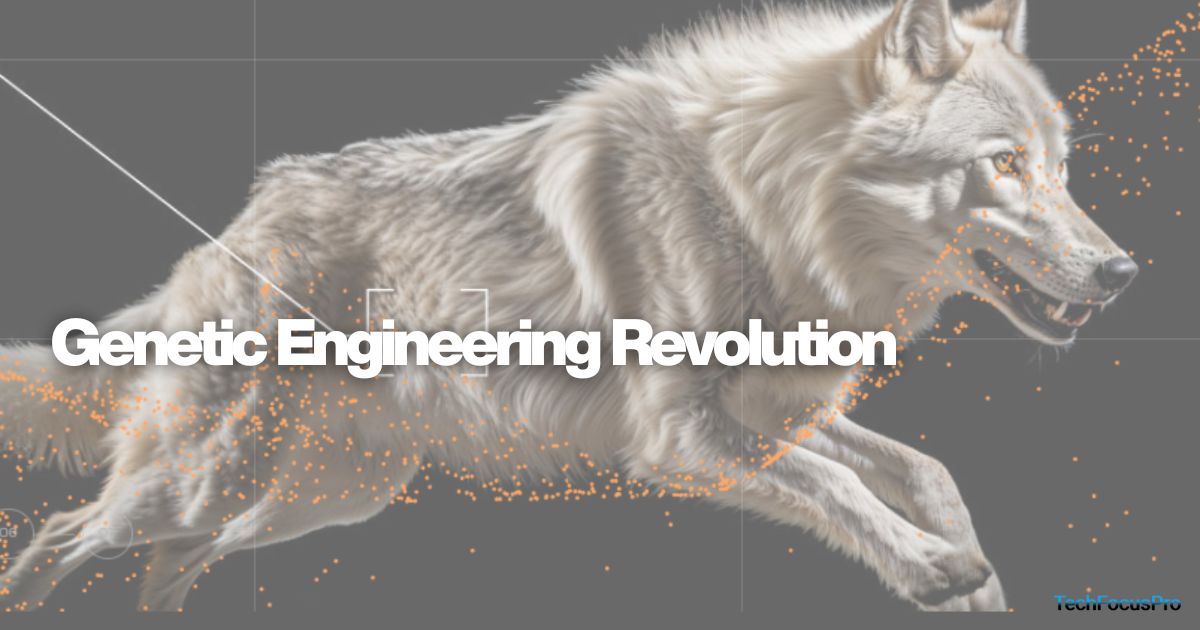CRISPR Meets Conservation: How Colossal’s Dire Wolf Breakthrough Sparked a Genetic Engineering Revolution

The genetic engineering revolution is transforming conservation biology at an unprecedented pace, and Colossal Biosciences stands at the forefront of this technological transformation.
While headlines often focus on bringing back extinct species, the most immediate impact lies in preventing future extinctions through advanced genetic rescue techniques.
The same CRISPR technologies that created the world’s first de-extinct dire wolves are now being deployed to save critically endangered species facing extinction today.
The Multiplex Gene Editing Breakthrough
At the heart of this conservation revolution lies multiplex gene editing—the ability to make numerous precise genetic modifications simultaneously. Colossal’s dire wolf project achieved a record-breaking 20 genomic edits across 14 genes, demonstrating unprecedented precision in genetic engineering for conservation applications.
“Each time you edit a gene in a cell, you put a lot of stress on that cell because you have to get your gene editing tools in these cells and these changes are made,” explained Dr. Beth Shapiro, Colossal’s Chief Science Officer. “So what we do instead is we try to make dozens or hundreds of changes at once. It’s called multiplex gene editing.”
This approach represents a quantum leap beyond traditional single-gene modifications. Rather than stressing cells through repeated interventions, scientists can now implement comprehensive genetic changes in one coordinated effort, dramatically improving success rates and opening possibilities for complex genetic rescue scenarios.
Dr. George Church, Harvard geneticist and Colossal co-founder, emphasized the significance: “The dire wolf is an early example of this, including the largest number of precise genomic edits in a healthy vertebrate so far. A capability that is growing exponentially.”
Genetic Rescue: Saving Species Through DNA
The applications of advanced genetic engineering extend far beyond de-extinction into immediate species rescue scenarios. Genetic rescue involves introducing beneficial genes into endangered populations to counteract inbreeding depression, restore lost genetic diversity, or provide resistance to emerging threats.
Traditional conservation approaches often prove too slow when facing rapid environmental changes or disease outbreaks. Climate change, habitat destruction, and invasive species are outpacing natural adaptation rates, leaving endangered species vulnerable to extinction despite conservation efforts.
“We can use biotechnologies to speed up the processes of selection and adaptation,” noted Dr. Shapiro. “With the successful birth of Colossal’s engineered dire wolf, we are one step closer to a world in which these tools are among those at our disposal to help species thrive in their rapidly changing habitats.”
Real-World Success Stories
The practical applications of genetic rescue are already delivering results. In Australia, researchers have used single base-pair edits to help endangered northern quolls survive encounters with invasive cane toads. This simple genetic modification provides resistance to toad toxins that would otherwise prove fatal.
“This represents a form of accelerated evolution, using genetic engineering to achieve in a laboratory what would normally take thousands of years of natural selection to evolve,” Dr. Shapiro explained.
Similar approaches could address numerous conservation challenges: engineering coral resistance to bleaching temperatures, providing amphibians immunity to chytrid fungus, or helping endangered plants survive changing precipitation patterns.
The Ghost Wolf Genetic Rescue Program
Colossal’s work with critically endangered ghost wolves demonstrates genetic rescue in action. With fewer than 20 individuals remaining in the wild, the species faces an extreme genetic bottleneck that threatens its long-term survival.
Using technologies developed for dire wolf de-extinction, Colossal successfully cloned four ghost wolf pups from three distinct cell lines, potentially increasing genetic diversity in the captive population by 25%. This achievement addresses one of the most critical challenges in ghost wolf recovery: limited genetic variation stemming from a founding population of only 12 individuals.
“We now have the technology that can edit DNA to increase resilience in species that are facing extinction or to revive extinct genetic diversity and species,” explained Dr. Bridgett vonHoldt of Princeton University, who collaborates with Colossal on ghost wolf genetics.
Biobanking Revolution
Advanced genetic techniques have also revolutionized biological sample collection and preservation. Colossal’s EPC (Embryonic Progenitor Cell) blood cloning platform—originally developed during the dire wolf program—enables conservationists to preserve genetic material from endangered species using minimally invasive blood draws rather than stressful tissue biopsies.
“The creation of less-invasive sampling tools such as our EPC blood cloning platform allows for the conservation community to ramp up biobanking efforts of those species on the brink,” noted Matt James, Colossal’s Chief Animal Officer.
This technology enables more comprehensive genetic preservation from wild populations, creating repositories that could prove invaluable for future genetic rescue efforts as populations decline further.
Read More: Precision Technologies International
Disease Resistance Engineering
One of the most promising applications involves engineering disease resistance into vulnerable species. Many endangered animals face extinction partly due to diseases for which they lack natural immunity—often introduced by human activities or spread due to climate change.
The technical capability to introduce multiple resistance genes simultaneously could provide comprehensive protection against disease threats. Rather than hoping for natural evolution to develop resistance over generations, genetic engineering could provide immediate protection.
Dr. Barney Long of Re:wild emphasized the potential: “From restoring lost genes into small, inbred populations to inserting disease resistance into imperiled species, the genetic technologies being developed by Colossal—including those first proven in the dire wolf—have immense potential to greatly speed up the recovery of species on the brink of extinction.”
Precision and Safety Protocols
The conservation applications of genetic engineering demand the highest levels of precision and safety. Every genetic modification must be carefully validated to ensure it produces intended benefits without unintended consequences.
Colossal’s approach involves rigorous testing at each stage. “We are, in every case, interested in making the fewest number of changes possible to still bring those animals back,” Dr. Shapiro noted. “We’re very carefully evaluating every single one of the edits that we make.”
This conservative approach ensures that genetic rescue efforts enhance rather than compromise endangered species’ survival prospects. Each edit undergoes comprehensive analysis through high-quality whole-genome sequencing, karyotyping, and bioinformatic verification.
The Gulf Coast “Ghost Wolves” Discovery
Genetic analysis capabilities—refined in the dire wolf genome project—have revealed unexpected conservation opportunities, such as the “ghost wolves” of the Texas and Louisiana Gulf Coast. These wild canids carry remnant ghost wolf DNA—genetic diversity thought lost when ghost wolf populations crashed.
Research led by Dr. vonHoldt and Dr. Kristin Brzesk aims to understand how this hidden genetic diversity could be integrated into ghost wolf recovery efforts. “Perfecting genomic tools to integrate ‘ghost alleles’ from Gulf Coast canids would increase ghost wolf genetic diversity,” explained Mike Phillips of the Turner Endangered Species Fund.
This discovery demonstrates how advanced genetic analysis can reveal hidden conservation resources and create new possibilities for species recovery.
Scaling Conservation Impact
The platform approach to genetic engineering enables conservation organizations to scale their impact dramatically. Rather than developing separate techniques for each endangered species, the multiplex editing capabilities create versatile tools applicable across multiple taxa.
Dr. Christopher Mason of Weill Cornell Medicine emphasized the broader implications: “The same technologies that created the dire wolf can directly help save a variety of other endangered animals. This is an extraordinary technological leap in genetic engineering efforts for both science and for conservation.”
Open Science and Collaboration
Recognizing that conservation challenges require collaborative solutions, Colossal has committed to making their genetic engineering tools and protocols publicly available. Research data, methodologies, and findings are shared through open-access databases and publications.
This approach accelerates conservation applications by enabling researchers worldwide to build upon Colossal’s advances. Rather than keeping proprietary advantages, the company views genetic rescue as a global challenge requiring shared resources and collective expertise.
Regulatory and Ethical Frameworks
The application of genetic engineering to conservation requires careful consideration of regulatory requirements and ethical guidelines. Colossal works closely with institutions like the American Humane Society and maintains external oversight through independent animal care committees.
The company also follows IUCN (International Union for Conservation of Nature) guidelines for genetic interventions in conservation, ensuring that genetic rescue efforts align with established conservation principles and best practices.
Future Applications and Expansion
As genetic engineering capabilities continue advancing, the applications for conservation will expand dramatically. Current research focuses primarily on single-species interventions, but future approaches might address ecosystem-level genetic challenges.
Potential applications include engineering beneficial gut microbiomes for endangered species, modifying plant species to provide better nutrition for herbivores, or creating genetic corridors that enable gene flow between isolated populations.
Training the Next Generation
The conservation genetic engineering revolution requires training new generations of scientists who understand both cutting-edge biotechnology and traditional conservation biology. Colossal’s collaborations with universities and research institutions help develop this interdisciplinary expertise.
“Hard work pays off, science is fun, and the biggest breakthroughs often come from taking calculated risks,” Dr. Shapiro advised future researchers. “Diverse experiences and viewpoints are assets that the biotech field desperately needs if we are going to take on the complex challenges that our global community will face in the next decades.”
A New Conservation Paradigm
The integration of advanced genetic engineering with conservation biology represents more than technological progress—it’s creating an entirely new paradigm for protecting biodiversity. Rather than simply managing decline, conservationists can now actively enhance species’ survival prospects through targeted genetic interventions.
As climate change accelerates and biodiversity loss continues, these tools may prove essential for preventing extinctions that traditional conservation approaches cannot address. The dire wolf breakthrough shows how powerful these technologies can be when translated from theory into practice.
The future of conservation increasingly depends on embracing these advanced biotechnologies—not as replacements for habitat protection and traditional conservation methods, but as powerful additions to the toolkit for protecting life on Earth.






